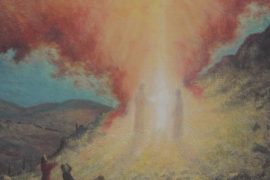Paul never met Jesus.
With those four words I began my book, Paul and Jesus (Simon & Schuster, 2013). Jesus was crucified in 30 CE, Paul had his visionary encounter with Jesus some years after that–seven years according to one early source (The Ascents of James). Accordingly, he is often called the “Thirteenth Apostle.” Here is how Paul recounts his experience in our earliest record of the “appearances” of Jesus after his resurrection from the dead in a six-part breakdown:
He appeared to Cephas (Simon Peter)
Then to the Twelve
Then he appeared to more than five hundred brethren at one time
Then he appeared to James
Then to all the apostles
Last of all, as to one untimely born, he appeared also to me (1 Corinthians 15:1-8)
Many read this account as if it is parallel to the various appearances and encounters with Jesus at the empty tomb and thereafter, in the gospels of Matthew, Luke, and John. The problem with this attempt at “harmonization” is that it simply does not work. The accounts in these gospels are written several decades after Paul’s testimony here, and none of them agree with one another. In fact they show a clear and emerging apologetic development. Mark has no appearances–only a promise of a future encounter in the Galilee, see my post “The Strange Ending of Mark. Matthew, Luke, and John reflect disparate traditions centered in Galilee and Jerusalem, mixing what seems to be more visionary encounters with “flesh and bone” meetings over a meal–or a combination of the two (compare Matthew 28:16-17; Luke 24:31, 36-42). Sorting through them is a real challenge, but I have attempted to do just that in a previous post that I think has had more readers than anything I have ever published on this blog: “Why People Are Confused about the Earliest Christian View of Resurrection of the Dead.” If you haven’t read that one I urge you to do so before you consider the points I want to make in this post on what Paul claims to have seen in his encounters with Jesus.
In addition to Paul’s account being earlier than that of the gospels it is the only first person account we have testifying to Jesus’ resurrection from the dead–with an extensive exposition of just what that claim meant by Paul himself. Most scholars agree that our New Testament gospels, with their traditional names (Matthew, Mark, Luke, John) are not direct first person testimony–but are rather secondary and derivative, each with its own particular theological purposes taking center stage.
So what do we learn from Paul and his firsthand account of his own experiences with the “risen Jesus”? Let’s look first at what he claims in his own words:
“Last of all he appeared to me . . .” (1 Corinthians 15:8)
“Have I not seen Jesus our Lord?” (1 Corinthians 9:1)
“For I did not receive it [his gospel message] from man, nor was I taught it, but it came through a revelation of Jesus Christ.” (Galatians 1:12)
“But when he who had set me apart before I was born, and had called me through his face, was pleased to reveal his Son to me . . . I did not confer with flesh and blood…(Galatians 1:15-16)
“For I received from the Lord what I also delivered to you, that the Lord Jesus on the night when he was betrayed took break . . . (1 Corinthians 11:23)
“I must boast, there is nothing to be gained by it, but I will go on to visions and revelations of the Lord.” (2 Corinthians 12:1)
“To keep me from being too elated by the abundance of revelations, a thorn was given me in the flesh, a messenger of Satan, to keep me from being too elated. Three times I besought the Lord about this, that it should leave me; but he said to me, ‘My grace is sufficient for you, for my power is made perfect in weakness.'” (2 Corinthians 12:7-9)
Notice–in all of Paul’s firsthand testimony he appeals to his encounters with the heavenly glorified Christ. In none of them does he report any kind of “flesh and blood” encounter with a human who has been brought back to life in a physical body–a kind of “resuscitated” corpse leaving behind an empty tomb.
Paul makes this abundantly clear in his exposition in 1 Corinthians 15 as he describes what is involved in the idea of “resurrection of the dead.” For Paul, resurrection of the dead is first and foremost a transformation from flesh and blood life to heavenly glorification. That means that Paul’s affirmation of the “dead in Christ” being raised is simply a way of affirming that the dead, along with the living who share that hope will together experience the metamorphosis from mortal to immortal. 1 Corinthians 15 is often called “The Resurrection Chapter” but it might be better called the “Transformation Chapter.” In a manner similar to what he writes in 1 Thessalonians 4, Paul wants to be sure that his followers understand that the dead as well as the living will participate in this grand Transformation.
In describing what this Transformation entails Paul sets forth a series of five contrasts:
Perishable vs. Imperishable
Decay vs. Glory
Weakness vs. Power
Physical body vs. Spiritual body
First Adam of the dust, living creature vs. Last Adam of heaven, a life-giving Spirit
Paul believes that at the appearance (Parousia or “arrival”) of Jesus in the clouds of heaven the dead–long ago decayed or turned to dust and ashes–will be “raised” in this glorious imperishable state as those living are similarly transformed from flesh to spirit–instantaneously, in the “blink of an eye.” In other words, for Paul, “resurrection of the dead” is centered on the question of whether those few who have died will also participate in this transformation, along with those living at the time! It is not about “reviving” the dead–but transforming mortal descendants of Adam to this new level of existence that Jesus, who was once a flesh and blood, has now experienced.
It all centers on heavenly exaltation and glorification. For Paul, the issue is not whether those who have died “in Christ” will be “raised” so much as will they participate, despite having died, in this heavenly transformation. And he answer with a resounding Yes!
Paul believes that Jesus died, was buried, and was so raised–to a level of heavenly glorification far above even the angels. He accordingly declares that those living and dead, “in Christ” will experience that same transformation.
When asked by skeptical doubters to describe “what kind of body” these transformed beings will have, he clearly says it is a state of being beyond our imagination–just as a seed decays in the soil, but comes forth in a wholly new form (acorn to oak tree)–so is the transformation from mortal to immortal bodies. He says that those who think they can try to visualize such an embodied state are “fools” for not realizing God’s creative power of transformation even in the physical creation of seeds and plants. How much more so with the transformation now seen with the resurrection of Jesus–who sits at the right hand of God exalted above all rule, authority and power.
Paul further likens the resurrection to “leaving behind” the old body, like a discarded set of clothes, entering a “naked” state of death, followed by a “reclothing” with a new spiritual body. Clearly the “old clothes” of the physical decaying body are of no consequence to him (2 Corinthians 5:1-5).
Paul’s bottom line: God will give those “in Christ” an indescribly glorious body–made like the new spiritual body that Jesus himself was given at his resurrection:
“But our Commonwealth is in heaven, and from it we await a Savior, the Lord Jesus Christ, who will change our lowly body to be like his glorious body, by the power which enables him even to subject all things to himself” (Philippians 3:20-21).
For Paul Jesus is the “firstborn of many to come,” a new family of glorified “children of God,” transformed from flesh and blood to the heavenly glorification and exaltation, who will share with Christ the work of judging the world–including angels! (1 Corinthians 7:2-3).
So back to my central question. When Paul claims to have “seen the Lord” what did he really see? Clearly what he saw and experienced, namely the flesh and blood Jesus transformed to an exalted glorious state, he can not describe. He insists that state is somehow “bodily,” but it is in no way the same body that Peter, James, and the other apostles and disciples knew in Jesus’ lifetime. As Paul says, “We no longer know Jesus according to the flesh…” (2 Corinthians 5:16).
Perhaps his core experience was seeing a blinding flashing light, that knocked him to the ground–as the book of Acts reports–characterized clearly as a “heavenly vision” (Acts 9:3-4; 22:6-7; 26:13-14, 19). It certainly seemed to have involved an audible “Voice,” since in the passages above Paul reports an “abundance” of such revelations of the Lord in the years following his initial encounter in which he believes he is hearing from “the Lord.” When he was taken to Paradise–whether “in the body or out of the body” he saw and heard “things unutterable.” Paul elsewhere speaks of the “light” that reflects the glory of God in the “face of Christ” who is in the likeness of God (2 Corinthians 4:4-6). He says further, in that specific context, “he who raised the Lord Jesus will raise us with you into his presence” (2 Corinthians 4:14). Since Paul expects to be alive when this happens he is clearly speaking of a glorification or exaltation from flesh to spirit.
But what is absolutely clear is that Paul did not see anything like what is reported in the gospels–where Jesus is seen by the Mary Magdalene, the other women at the tomb, Peter, and the other apostles–as the same embodied corpse that was laid in the tomb–but living, breathing, and eating again–as Luke puts it, a wounded body of “flesh and bones.”
So this sharp contrast raises a central question. Since Paul equates his encounter with the glorious exalted “risen” Christ with that of Peter, James, the Twelve, and the other apostles, including 500 followers in mass–isn’t it likely that the experience of these witnesses who came before Paul was much like his? After all, Paul knew Peter, James, John, and all the apostles and must have heard directly from them as they related their experiences. In other words, the earliest experience of Jesus’ followers following his death and burial was something akin to an indescribable encounter with a glorious heavenly being that they were convinced represented Jesus of Nazareth, transformed from flesh to spirit! Just as Paul in Acts responds to the light and the voice he heard asking–Who are you Lord?–they connected their visionary experience with the Jesus that had known.
I should also point out here that many scholars consider Mark’s account of Jesus’ Transfiguration was a proleptic scene of his notion of Jesus’ resurrection–and thus he needs no “appearances” at the end. Thus the women at the tomb are told to instruct the disciples to “go to Galilee” where they will see him as he promised–transformed into a glorious state (Mark 9:1-8). Mark seems to equate this visionary experience as nothing less than “the kingdom of God coming with power” (Mark 9:1).
Finally, It is worth noting on this point that in the only account we have of James and his testimony to his own faith in Jesus’ resurrection, when questioned by Jewish opponents in the Jerusalem Temple just before he was murdered by a mob, he answered “He is sitting in heaven on the right hand of great power, and he will come on the clouds of heaven” (Hegesippus, in Eusebius Church History 2.23.12-13). I might also add that the letter of James refers to God as the “Father of Lights” (James 1:17). Likewise, the first letter of Peter speaks of “God who raised him from the dead and gave him Glory” (1 Peter 1:21).
One of my chapters in my book, Paul and Jesus, is about what I call “reading the Gospels backward.” What I mean is that Paul is our primary source for understanding the resurrection of Jesus, and the way he presents his own encounter and revelation should take priority over the later accounts in the gospels that move toward more of a “flesh and blood” encounter–for obvious polemical and apologetic reasons. In the second generation, after the disruption of 70 CE, critics of the faith of Jesus’ followers attacked the claim that he was “raised from the dead” as illusionary–something akin to someone claiming to have seen a ghost. In order to counter this attack, and to insist that Jesus’ resurrection was more than “visionary,” we can trace the tendency to tie it more and more to the “flesh and bone” body that was laid in the tomb.
The same kind of apologetic motivation continues to drive many so-called “Evangelical” Christians today. They want something “concrete” to present to a skeptical world–so they use the gospels to cobble together a set of “undeniable” proofs, that Jesus’ first followers experienced his resurrection as a revival of his physical body–however “enhanced” in its capacities. They fear that anything less could be dismissed as “merely visionary,” and thus perhaps delusional. The problem with this approach is that all the claims of revelation in the entire Bible–are subject to this objection. Perhaps Abraham was deluded when he heard the Voice in Genesis 12, or Moses at the burning bush in Exodus 3, or any of the Prophets who claims to hear and transmit the Word of the LORD/Yahweh. The kinds of claims that biblical “revelation” rests upon transcend any sort of “scientific proof” such as coveted by this sort of apologetic attempt to convince skeptics. Biblical “faith” is transmitted by stories and narratives, and the few first person accounts we do have–such as that of Jeremiah (1:4-10) or Paul–are not really subject to our historical examination removed by thousands of years. But at least we can represent the claims made by such first person witnesses for what they say–not by our own need to somehow “defend” or “prove” biblical revelation.
That old evangelical saw that the apostles were either lying, deceived, or telling the truth falls flat in the face of human experience. Paul reports what he experienced–that is the limit of what we can say. But we can at least take what he says, for example, that the glorified body of Christ he says he encountered is not anything that he can describe. It was as different from the physical body as an acorn to an oak tree or a caterpillar to a butterfly–and in the end he has no idea other than it will be glorious, powerful, and immortal.
For Paul, the resurrection of Jesus had nothing to do with someone coming “back from the dead,” we have several tales of that in the Hebrew Bible as well as four such stories in the New Testament. Matthew even reports multiple tombs being opened and people appearing to others when Jesus died–presumably these folk lived a bit longer and then died a second time. There is no implication that they become glorified, transformed, heavenly beings, exalted over men and angels at the right hand of God. But that is precisely what Paul has in mind when he affirms his own experience of having “seen the Lord.” Of that point there can be no misunderstanding.
All this is to say, and this is nothing new with me, that the earliest view of Jesus’ resurrection from the dead was that of heavenly transformation and exaltation from flesh and blood to immortal life-giving spirit. It was that faith that drove James, Peter, Paul, and all the apostles and disciples who claimed to have experienced “the risen Christ.” It in fact had to do with Paul’s conviction that the physical “creation itself” was beginning to experience its liberation from “bondage to decay” with the promise then of a new heavens and a new earth, inaugurated in time and space history with Jesus’ glorification and exaltation (Romans 8:18-25).
P.S. I highly recommend the new book by Bruce D. Chilton, Resurrection Logic: How Jesus’ First Followers Believed God Raised Him from the Dead for further reading on this important topic.








Comments are closed.